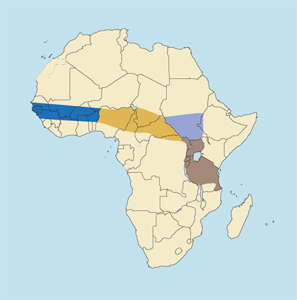 |
 |
Redunca redunca wardi
DESCRIPTION The eastern bohor reedbuck-at least in the northern portion of its range-is the most deeply colored of the bohor reedbucks, being quite reddish, with the black stripe on the forelegs well marked. The horns are large, with the tips hooked sharply forward and usually inward.
DISTRIBUTION The northeastern corner of Congo (K), Uganda, southern Kenya, Rwanda, Burundi, and Tanzania.
The distribution range of the eastern bohor reedbuck overlaps that of the common reedbuck in parts of Tanzania. Both species have been seen side by side in several localities, but the bohor reedbuck tends to be dominant in areas of flood plains, open grasslands and reedbeds, while the common reedbuck dominates in the uplands and in grassy valleys and glades within Miombo woodlands, and to a lesser extent Brachystegia woodlands.
PLEASE NOTE Misclassification has been a problem with this animal. Many "eastern bohor reedbucks" entered for the Record Book from southern Tanzania have, on examination, proven to be young common reedbucks. It is possible to confuse a young common reedbuck with an adult bohor; however, it should be kept in mind that a common reedbuck (1) is considerably larger than a bohor; (2) is normally a darker, duller color; (3) grows much larger horns that are evenly curved and do not form hooks at the ends; and (4) exhibits much more basal pulp, which is the incipient or "green" horn material at the base of the horns. Hunters should learn what these animals look like before hunting them.
TAXONOMIC NOTES Includes dianae (northeastern Congo [K]), tohi (southeastern Kenya and eastern Tanzania), and wardi (eastern Congo [K], Uganda, southwestern Kenya, Rwanda, Burundi and western Tanzania), with wardi Thomas, 1900 having priority.
|





